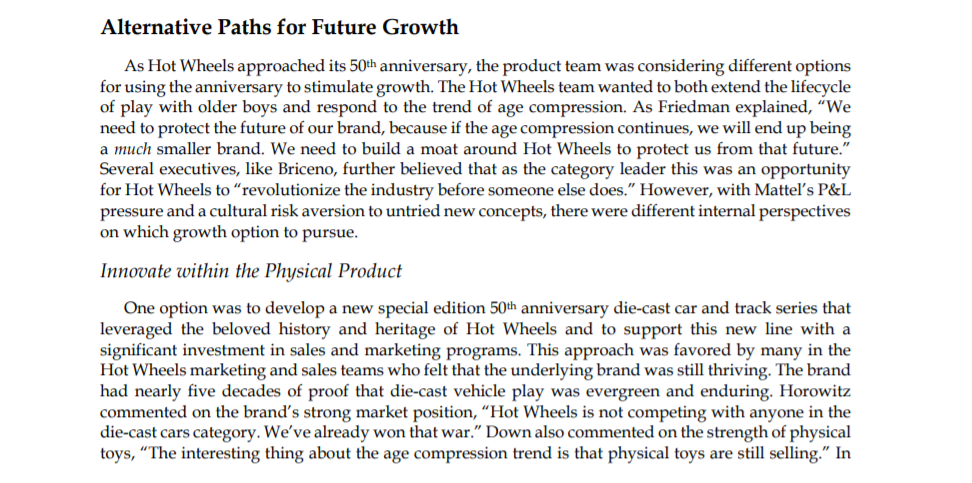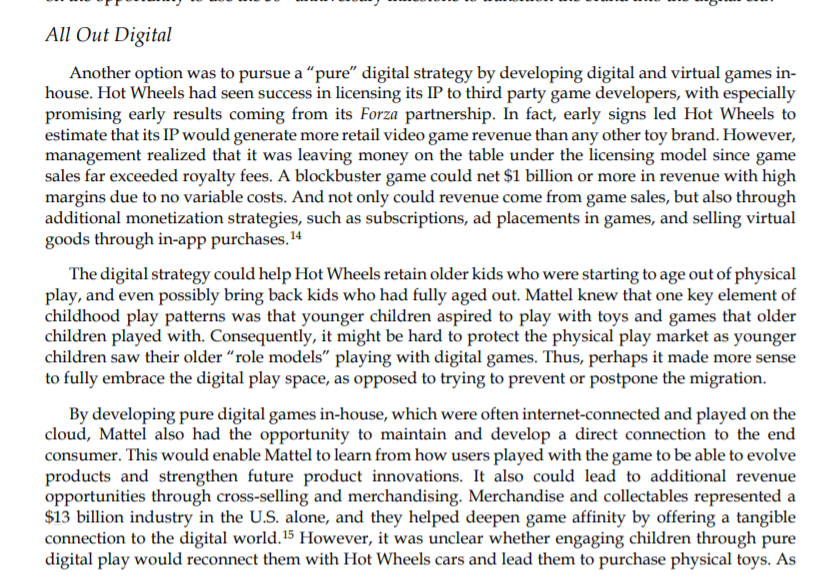Answered step by step
Verified Expert Solution
Question
1 Approved Answer
Please Answer question with a 3 paragraph response Summarize the pros and cons of each of the three alternatives in the case? Offer your recommendation
Please Answer question with a 3 paragraph response



Summarize the pros and cons of each of the three alternatives in the case?
Offer your recommendation to the best alternative?
Alternative Paths for Future Growth As Hot Wheels approached its 50th anniversary, the product team was considering different options for using the anniversary to stimulate growth. The Hot Wheels team wanted to both extend the lifecycle of play with older boys and respond to the trend of age compression. As Friedman explained, "We need to protect the future of our brand, because if the age compression continues, we will end up being a much smaller brand. We need to build a moat around Hot Wheels to protect us from that future." Several executives, like Briceno, further believed that as the category leader this was an opportunity for Hot Wheels to "revolutionize the industry before someone else does." However, with Mattel's P&L pressure and a cultural risk aversion to untried new concepts, there were different internal perspectives on which growth option to pursue. Innovate within the Physical Product One option was to develop a new special edition 50th anniversary die-cast car and track series that leveraged the beloved history and heritage of Hot Wheels and to support this new line with a significant investment in sales and marketing programs. This approach was favored by many in the Hot Wheels marketing and sales teams who felt that the underlying brand was still thriving. The brand had nearly five decades of proof that die-cast vehicle play was evergreen and enduring. Horowitz commented on the brand's strong market position, "Hot Wheels is not competing with anyone in the die-cast cars category. We've already won that war." Down also commented on the strength of physical toys, The interesting thing about the age compression trend is that physical toys are still selling." In All Out Digital Another option was to pursue a pure digital strategy by developing digital and virtual games in- house. Hot Wheels had seen success in licensing its IP to third party game developers, with especially promising early results coming from its Forza partnership. In fact, early signs led Hot Wheels to estimate that its IP would generate more retail video game revenue than any other toy brand. However, management realized that it was leaving money on the table under the licensing model since game sales far exceeded royalty fees. A blockbuster game could net $1 billion or more in revenue with high margins due to no variable costs. And not only could revenue come from game sales, but also through additional monetization strategies, such as subscriptions, ad placements in games, and selling virtual goods through in-app purchases. 14 The digital strategy could help Hot Wheels retain older kids who were starting to age out of physical play, and even possibly bring back kids who had fully aged out. Mattel knew that one key element of childhood play patterns was that younger children aspired to play with toys and games that older children played with. Consequently, it might be hard to protect the physical play market as younger children saw their older role models playing with digital games. Thus, perhaps it made more sense to fully embrace the digital play space, as opposed to trying to prevent or postpone the migration. By developing pure digital games in-house, which were often internet-connected and played on the cloud, Mattel also had the opportunity to maintain and develop a direct connection to the end consumer. This would enable Mattel to learn from how users played with the game to be able to evolve products and strengthen future product innovations. It also could lead to additional revenue opportunities through cross-selling and merchandising. Merchandise and collectables represented a $13 billion industry in the U.S. alone, and they helped deepen game affinity by offering a tangible connection to the digital world. 15 However, it was unclear whether engaging children through pure digital play would reconnect them with Hot Wheels cars and lead them to purchase physical toys. As Toys-to-Life/Mixed Play A third option was a hybrid approach of blending physical play with digital play an idea partly based on what was known in the market as toys-to-life," but that Mattel reconceived into what it called mixed play." The toys-to-life concept centered around using technology to allow a toy to be represented, or come to life in the digital world. The toys-to-life market had been launched in 2011 with the introduction of Skylanders, a physical and digital game developed by Activision. Skylanders had been a major hit, with sales topping $3 billion by 2016 and over 250 million toys sold. 21 By 2016 the toys-to-life category had grown into a multi-billion market, inviting several entrants.22 However, Mattel saw the toys-to-life concept as one-directional: the physical product was primarily used to unlock access to the digital world. Mattel's mixed play concept envisioned a bi-directional play experience, where the physical play was a highly engaging stand-alone experience that enhanced the digital play experience, and the digital play experience enhanced the physical play experience. As Wu explained, There is a spectrum. On one end there are products like Fitbit where the companion app complements the physical experience you are not going to get the Fitbit app without wearing a physical Fitbit device. On the other end are standalone digital games where they are not connected to a physical play experience at all. We would want kids to play in the digital world, but to also play meaningfully in the physical world, and have those two worlds constantly connect." Gerjets added, "The physical component should not just be an entry point to digital play, nor should the digital component just be a reward for physical play." Hot Wheels had met with a company that developed a near-field communication (NFC) chip that appeared to be a feasible tech solution for this type of product. NFC was a wireless communication protocol, similar to Bluetooth, that enabled one device to communicate with another NFC-enabled device from a close range. However, unlike Bluetooth which required pairing and manual device discovery, the NFC connection was automatic when two NFC-enabled devices were within the NFC's four-inch range. Newer generation smartphones were equipped with NFC, and it was the technology that enabled Apple Pay and Samsung Pay to work when a smartphone was close to a contactless reader. 23 It was a low-cost technology that was already being used by other gaming platforms, including Nintendo, PlayStation, and Xbox. By inserting an NFC chip into a Hot Wheels car, the toy could be scanned into a portal and become gamified in an app on an iPad or a mobile phone. One key advantage of recent advances in NFC chips was that they could capture information from devices moving at high speeds -- an important feature to enable play with Hot Wheels cars. Other benefits of the NFC chip were that it could digitally connect a device without battery power, it was easy and intuitive to use, reliable, inconspicuous, and it enabled strong data security and almost infinite serializationStep by Step Solution
There are 3 Steps involved in it
Step: 1

Get Instant Access to Expert-Tailored Solutions
See step-by-step solutions with expert insights and AI powered tools for academic success
Step: 2

Step: 3

Ace Your Homework with AI
Get the answers you need in no time with our AI-driven, step-by-step assistance
Get Started


